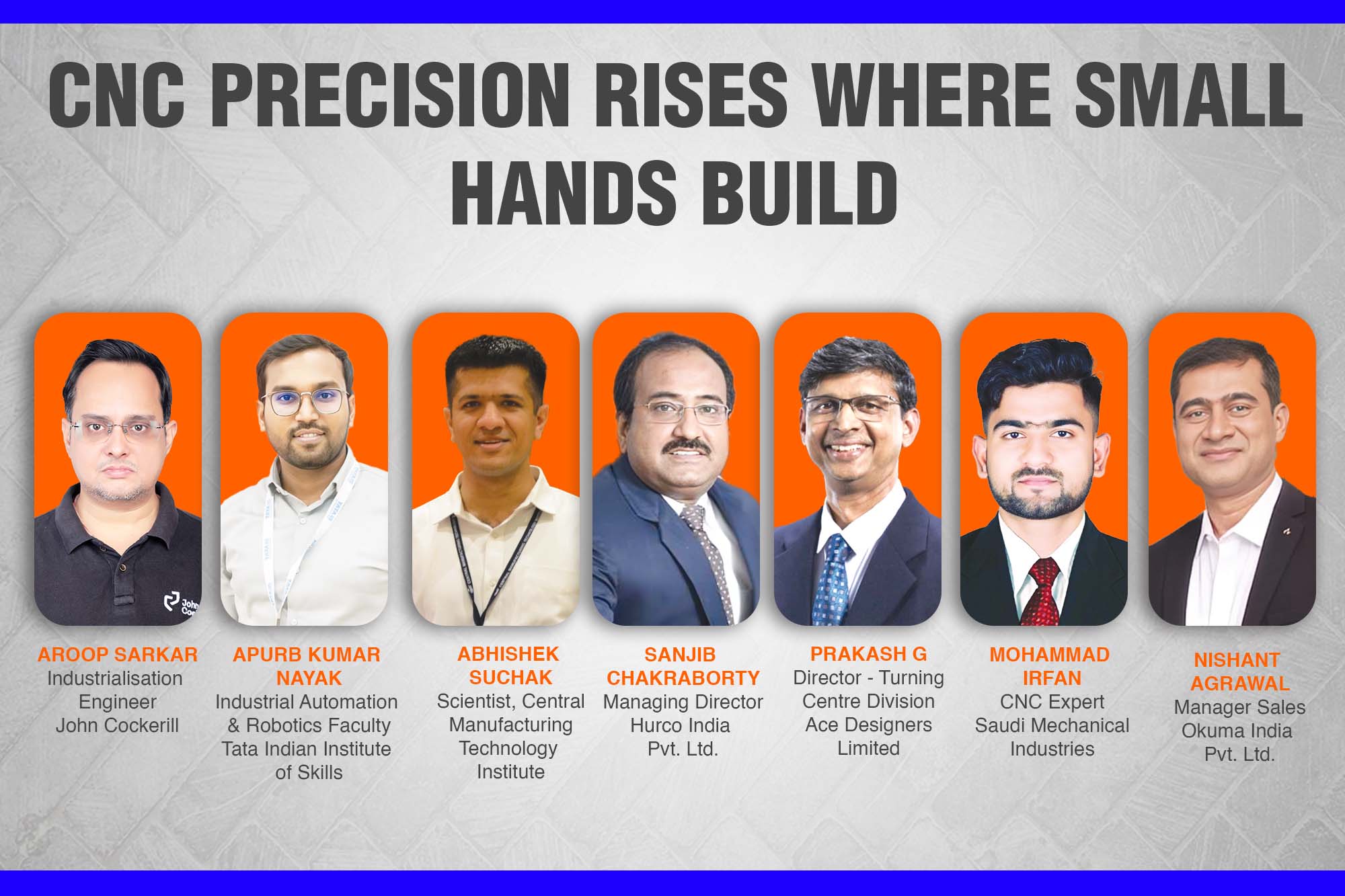Manufacturing 2023 TIGER ON THE STAGE
By OEM Update Editorial January 11, 2023 4:59 pm IST
The 2023 manufacturing outlook is accelerating, turning challenges into opportunities. Manufacturing sector trends can help organisations turn risks into initiatives on a roadmap to growth.
The initiatives drive future competitiveness, so new horizons for the future need to be explored. Technology encourages innovation since digital transformation is a winning factor in a competitive market. Despite supply chain bottlenecks, labour shortages, and a sluggish economic environment, the manufacturing industry continues to better the expectations of previous years, which were
affected partly due to the emerging pandemic. To maintain this growth, industry leaders should leverage digital technologies, adopt strategies for the smart future, and propel supply chain
resiliency into systems.
Glimpse into manufacturing optimism
Today’s manufacturing demands conducting remote analysis on equipment to identify potential issues before a malfunction occurs, for which IoT has proven to be a boon. IIoT extending application to industrial application is a major trend in the manufacturing sector. The IoT in the manufacturing market will reach up to $399.08 billion in value by 2026 at a Compound Annual
Growth Rate of 14.5 percent. Manufacturers’ investment in IoT will only increase in 2023 and beyond. Product as a Service has cemented IIoT’s status as a leading trend for the year. Moreover, supply chain issues, including logistics demand, cost pressures, and cyberattacks, will likely remain critical challenges in 2023. As the recent National Association of Manufacturers (NAM) survey highlighted, these disruptors have affected manufacturers’ optimism and business confidence.
Commenting on the manufacturing outlook for 2023 in India, Paul Weaver, Director of Sales & Marketing India, Renishaw Metrology Systems Limited, said, “Last year India rose to number two on the Global Manufacturing Index, showing how the market is growing in the region. In the coming year, 2023 will likely continue its growth momentum on the back of sustaining domestic demand.”
To sustain this development, Indian manufacturers must use digital technology, implement policies for the future of work, and foster resilient supply chains. A globally competitive manufacturing sector is our greatest opportunity for economic expansion and job creation over the next decade. Recalling the projection in the union budget of 2022, Shivaji Waghmare, CEO, Fuji Electric India Pvt. Ltd., remarked, “Our Indian Finance Minister projected 9.2 percent economic growth while presenting the Union Budget earlier this year. However, changes in the global economy have had far-reaching effects. Since then, India growth forecasts have been repeatedly lowered. “If bad global economic conditions lead to a slowdown in consumption in developed economies, it will negatively influence India’s exports. The manufacturing sector outperforms past years’ estimates despite supply constraints, workforce shortages, and an uncertain economic climate.”
The manufacturing outlook for 2023 is promising and industrial expansion will be a crucial driver. The manufacturing industry operates in varying and often extreme conditions, warranting the need for superior and stable equipment performance. Talking about smooth manufacturing, Deepak Miglani, General Manager, Industrial Lubricants, ExxonMobil Lubricants Pvt. Ltd., states, “Quality lubricants and cutting oils are key enablers of high performance in high-pressure situations, making manufacturing operations smooth, productive, efficient, and profitable. The machine tools segment features prominently in research, development and vision for 2023 and beyond. Combining superior solutions and reliable services is a key driver for the manufacturing sector and machine tool operators.”
The manufacturing outlook looks positive; people are investing and buying more machines. Many new projects are being announced. The current trend will continue to be a successful year in 2023. Jay Shah, Managing Director, Tungaloy India, considers manufacturing advancement with a strong perspective. He says, “Make in India is a big blessing for the Indian manufacturing industry. Because of this, many industries have now started investing in the Indian market, and this is a great push for development.”
Major trends
Predictive maintenance
Predictive maintenance has been at the forefront of manufacturing. Predictive maintenance uses data analysis to identify anomalies in equipment performance and determine their root cause. Predictive resolution takes this concept one step further, offering technicians insights on resolving those issues with greater certainty. It remains a key manufacturing trend for 2023 but looks slightly different than in years past. Instead of predictive maintenance, manufacturers are in the early stages of adopting the predictive resolution. The technology is more affordable, opening manufacturers up to new possibilities. By using predictive resolution in conjunction with IIoT, manufacturers can ensure that production assets and equipment operate as intended. It proactively addresses issues before they have the chance to lead to unplanned downtime and extend machinery life.
IIoT into 2023
A paradigm shift is happening from Industry 4.0 to Industry 5.0 by integrating digitalisation and AI/ML in key product and service offerings. Implementing digital technology or digitalising processes is a key trend for growth momentum. IoT, AI, MI, Industry 4.0 and Industry 5.0 are the ongoing trends refurbishing the manufacturing sector growth. Businesses know if they do
not start incorporating AI/ML now, they will lose because they know that their competitors are doing it. It has become an essential activity. From a role standpoint, companies should have a demand analyst or a data scientist, an analytical resource who can work with the data and make the machine run. Speaking about how AI will continue to shape the workplace of the future, Igor Rikalo, President and COO at o9 Solutions, asserts, “A key aspect of any technology, including AI, is that it should augment human capabilities by providing computational models, powered by relevant data, to enable fact-based and unbiased decision-making.”
Manufacturers have increased their digital investment over the past few years and accelerated the adoption of emerging technologies. They were able to pivot faster than manufacturers with limited digital capabilities. Companies with higher digital implementation tend to have increased supply chain visibility and can better adapt to supply chain challenges.
Igor believes, “There is a continued need for companiesto invest in new processes, organisational models, and technologies. It will help manage supply chain complexities and costs and potentially sense disruptors before they impact the supply chain. Organisations anticipating and managing disruptions will set themselves up as industry leaders.”
The manufacturing outlook in the country should continue the growth momentum, considering that many domestic and FDI projects have been announced in recent times. According to Vineet Seth, Managing Director – South Asia & Middle East, Mastercam APAC, “On the Defence, Infrastructure and Transportation end, there is an all-time high of investments in new projects too. I would take a bullish approach to 2023, despite negative sentiments rumoured for the global economy in 2023.” Chip manufacturing has caught the attention of many prominent players in the market, and work is progressing rapidly in this domain. The pent-up and increased demand for passenger vehicles in the country is also expected to carry forward into 2023, gathering manufacturing momentum for newer variants. Several newer airline companies starting operations in India will mean continued MRO and unique aircraft in play.
According to a report published by Deloitte, continued investments in advanced manufacturing technologies can help develop the required impetus. The high level of uncertainty is expected to continue over the next one and half years. The manufacturers’ digital strategies over this period are likely to be based on many of the following dynamics as shown in infographics herein.
(Surveyed manufacturers planned to focus on various technologies to improve operational efficiencies over the next 12 months—source: www2.deloitte.com.)
Manufacturing momentum
Manufacturing has continued strength in 2022, building on its momentum from the pandemic. The report suggests that suggests that overall demand and production capacity have recently hit highs. The near-term outlook may need to be more brightly. After a strong rebound in 2022, the tower for local manufacturing in the year ahead is wobbling. This scourge of the pandemic has to go down the dust with the government prepared to overcome the invisible looming challenges.
However, Anil Anand, Director, Kistler Instrument IndiaPvt. Ltd., believes that with the last two years of backlog, the economy and the manufacturing sector are poised for heavy growth in the coming years, and that is what we all expect. “On the global stage, with major countries’ abridging and snapping business activities with China, India should become an alternate manufacturing hub for opening more manufacturing industries in India. That is the thing that is happening on the global stage. So, keeping that in mind, 2023 should be an exciting next year.”
Beacon to future
Chip manufacturing has caught the attention of many prominent players in the market, and work is progressing rapidly in this domain. The pent-up and increased demand for passenger vehicles in the country is also expected to carry forward into 2023, gathering manufacturing momentum for newer variants, says Vineet. The industry is poised for growth despite anticipated challenges. The acceleration gained in 2022 is expected to continue into 2023, though supply challenges, labour shortages, and an uncertain economic environment will persist. A central focus area is a growing focus on attracting and retaining talent through upskilling and reskilling. Energy price volatility, higher labour costs, and inflation worries could affect the industry. However, combining superior solutions and reliable services is a key driver for the manufacturing sector and machine tool operators, says Deepak.
The innovations and solutions pioneered in 2022 are expected to gain momentum in 2023, potentially altering tried-and-true business practices to pursue growth and productivity. Conclusively adapting strategies to create smart factories is the rethink that manufacturing companies should adopt to move on in 2023. The manufacturing trends will lend credibility in 2023 to propel India’s expectation to become a US$ 5 trillion economy. And the vision of Aatmanirbhar Bharat is indicative of optimism for manufacturing growth in 2023 and is an assumption that is a strong bet for the industries and companies in the manufacturing sector.
Cookie Consent
We use cookies to personalize your experience. By continuing to visit this website you agree to our Terms & Conditions, Privacy Policy and Cookie Policy.















